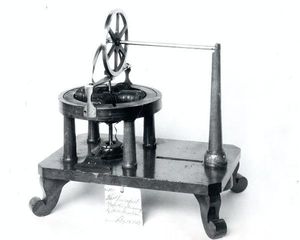Electric Motor: Difference between revisions
From ETHW
No edit summary |
(CSV import of Timeline data) |
||
| (9 intermediate revisions by 2 users not shown) | |||
| Line 1: | Line 1: | ||
'''''This article is a stub. You can help the | '''''This article is a stub. You can help the ETHW by expanding it.''''' | ||
[[Image:Davenport Electric Motor 0116.jpg|thumb|right|Davenport's Motor]] | |||
[[Category:Power | Rutland, Vermont. Thomas Davenport invented [[Davenport's Motor|his electric motor]] in 1834, but didn't apply for a patent until 1836. U.S. patent No. 132 entitled "Improvements in propelling machinery by magnetism and electro-magnetism" was granted to him on 25 February 1837. Unlike past models that were too weak for practical purposes, Davenport's motors grew powerful enough to run lathes, drills and even printing presses. | ||
[[Category:Electromechanical_systems]] | |||
[[Category:Motors]] | |||
[[Category:Energy|Category:Power,_energy_&_industry_application]] [[Category:Electromechanical_systems]] [[Category:Motors]] | |||
{{Timeline | |||
|Date=1/25/1837 | |||
|Priority=Electrical | |||
|Description=Thomas Davenport received a patent for his electric motor, invented in 1834, on 25 February 1837 in Rutland, Vermont. He had not applied until 1836. Unlike past models that were too weak for practical purposes, Davenport's motors grew powerful enough to run lathes, drills and even printing presses. | |||
}} | |||
Latest revision as of 06:41, 23 November 2017
This article is a stub. You can help the ETHW by expanding it.
Rutland, Vermont. Thomas Davenport invented his electric motor in 1834, but didn't apply for a patent until 1836. U.S. patent No. 132 entitled "Improvements in propelling machinery by magnetism and electro-magnetism" was granted to him on 25 February 1837. Unlike past models that were too weak for practical purposes, Davenport's motors grew powerful enough to run lathes, drills and even printing presses.
